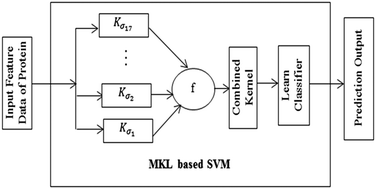Protein subcellular localization prediction using multiple kernel learning based support vector machine†
Abstract
Predicting the subcellular locations of proteins can provide useful hints that reveal their functions, increase our understanding of the mechanisms of some diseases, and finally aid in the development of novel drugs. As the number of newly discovered proteins has been growing exponentially, which in turns, makes the subcellular localization prediction by purely laboratory tests prohibitively laborious and expensive. In this context, to tackle the challenges, computational methods are being developed as an alternative choice to aid biologists in selecting target proteins and designing related experiments. However, the success of protein subcellular localization prediction is still a complicated and challenging issue, particularly, when query proteins have multi-label characteristics, i.e., if they exist simultaneously in more than one subcellular location or if they move between two or more different subcellular locations. To date, to address this problem, several types of subcellular localization prediction methods with different levels of accuracy have been proposed. The support vector machine (SVM) has been employed to provide potential solutions to the protein subcellular localization prediction problem. However, the practicability of an SVM is affected by the challenges of selecting an appropriate kernel and selecting the parameters of the selected kernel. To address this difficulty, in this study, we aimed to develop an efficient multi-label protein subcellular localization prediction system, named as MKLoc, by introducing multiple kernel learning (MKL) based SVM. We evaluated MKLoc using a combined dataset containing 5447 single-localized proteins (originally published as part of the Höglund dataset) and 3056 multi-localized proteins (originally published as part of the DBMLoc set). Note that this dataset was used by Briesemeister et al. in their extensive comparison of multi-localization prediction systems. Finally, our experimental results indicate that MKLoc not only achieves higher accuracy than a single kernel based SVM system but also shows significantly better results than those obtained from other top systems (MDLoc, BNCs, YLoc+). Moreover, MKLoc requires less computation time to tune and train the system than that required for BNCs and single kernel based SVM.



 Please wait while we load your content...
Please wait while we load your content...